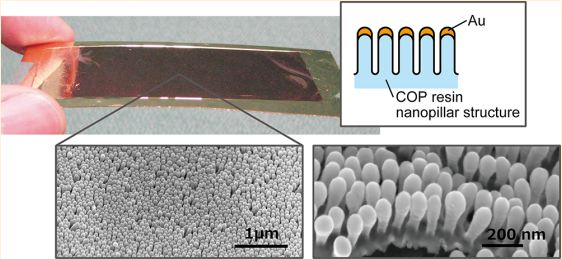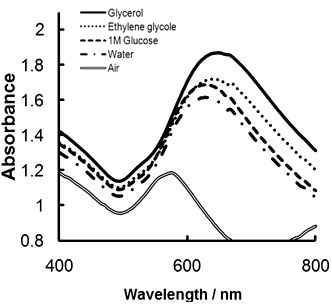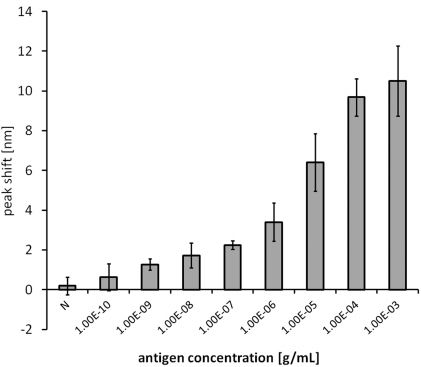研究成果47
Novel Gold-Capped Nanopillars Imprinted on a Polymer Film for Highly Sensitive Plasmonic Biosensing
Masato Saito, Akito Kitamura, Mizuho Murahashi, Keiichiro Yamanaka, Le Quynh Hoa, Yoshinori Yamaguchi, and Eiichi Tamiya
Anal. Chem., 2012, 84 (13), pp 5494-5500


Absorption spectrum of Au-capped nanopillars, when they were surrounded by air (n = 1.0), water (n = 1.33), 1 M glucose (n = 1.35), ethylene glycol (n = 1.43), and glycerol (n = 1.47).

Calibration curve for the IgG-anti IgG measurement using Au-capped nanopillar LSPR based-chip. N is 1 μg/mL of CRP as a negative control.
Biosensing with LSPR has the merit of label-free measurement with a highly sensitive signal at long wavelengths. It is widely known that the collective charge density oscillations of nanoparticles are defined as localized surface plasmon resonance. LSPR, in turn, enhances an immediate change in the interfacial refractive index (RI) of the surrounding medium; thus, the signal is greatly afected by the attachment of biomolecules. The excitation of LSPR by light at an incident wavelength, where resonance occurs, results in the appearance of intense surface plasmon (SP) absorption bands. The intensity and position of the SP absorption bands are characteristic to the type of nanomaterial, the diameter of the nanoparticles, and their distribution. Thus, for the development of practical LSPR biosensors, a reliable mass nanofabrication method for noble-metal nanoparticles is one of the key challenges.
In this study, we have developed a novel Au-capped nanopillarplasmonic biosensor based on the combination of porous alumina fabrication and thermal nanoimprinting techniques. A nanoporous alumina was fabricated to use as a mold in transforming nanopillar structures onto a thin film polymer by thermal nanoimprint lithography (NIL). The size of the pores was successfully controlled by varying the applied voltages and etching time. These nanoporous structures were transferred to the Cyclo-olefin polymer (COP) film surface from the porous mold by a thermal nanoimprinting process. A plasmonic substrate was fabricated by sputtering a thin layer of gold onto this nanopillar polymer structure, and the refractive index response in a variety of media was evaluated. Finally, the biosensing capacity of this novel plasmonic substrate was verified by analysis of Human immunoglobulin and achieved a minimum detection limit of 1.0 ng/ mL. With the advantages of mass production with consistent reproducibility stemming from the nanoimprint fabrication process, our gold-capped polymeric pillars are ready for the transition from academic interest into commercialization systems for practical use in diagnostic applications.






